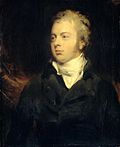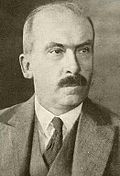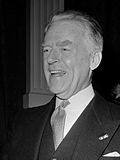De Nederlandsche Bank
The Netherlands' central bank From Wikipedia, the free encyclopedia
The Netherlands' central bank From Wikipedia, the free encyclopedia
 | |
 | |
| Headquarters | Amsterdam |
|---|---|
| Established | 25 March 1814 |
| President | Klaas Knot |
| Central bank of | the Netherlands |
| Reserves | 8 840 million USD[1] |
| Succeeded by | European Central Bank (1999)1 |
| Website | dnb |
| 1 De Nederlandsche Bank still exists but many functions have been taken over by the ECB. | |
De Nederlandsche Bank (DNB, lit. 'The Dutch Bank') is the Dutch member of the Eurosystem and has been the monetary authority for the Netherlands from 1814 to 1998, issuing the Dutch guilder. Since 2014, it has also been the country's national competent authority within European Banking Supervision.[2] It was originally founded by King William I, and has been since transformed into a state-owned public limited company (Dutch: naamloze vennootschap, abbreviated NV).
On 2 May 1998, the European heads of state or government decided that the Economic and Monetary Union (EMU) would begin on 1 January 1999 with eleven member states of the European Union (EU), the Netherlands included. As from 1 June 1998, the Dutch central bank, De Nederlandsche Bank N.V., forms part of the European System of Central Banks (ESCB). On the same day, the new Bank Act (of 1998) came into force. Nearly 185 years into its existence, the Nederlandsche Bank has entered a new phase.
Under the 1998 Bank Act – replacing that of 1948 – the bank has the following tasks:
The first two tasks – also known as the ESCB tasks – ensue entirely from the Maastricht Treaty. Decisions in these areas are taken at the European level by the ECB Governing Council, on which the president of the Nederlandsche Bank has a seat. Promoting the smooth operation of payment systems has both a European and a national dimension. The statistical task is also partly ESCB-related and partly a national concern. The DNB is responsible for international macro-economic statistical analysis for countries outside the EU.[3] These two tasks will not be transferred to ESCB level at the start of EMU. Here the Nederlandsche Bank remains fully in control. However, in a Europe where economies are becoming increasingly interlocked, many banking supervisory rules are drawn up at the international level. DNB serves as the banker's bank to general Dutch banks.
One of the government appointed members of the Social-Economic Council is always a representative of DNB.
The bank was established from the start on Oude Turfmarkt, where it occupied 17th-century houses. In the 1860s, a purpose-built head office, designed by architect Willem Anthonie Froger, was erected on the same location and inaugurated in 1869. Nearly a century later in 1968, as the bank has left the building for its new seat, it was taken over by the University of Amsterdam which had long been established just nearby, and subsequently repurposed as the location of the Allard Pierson Museum, which opened there in October 1976.[4]
In the 1960s, a new head office complex was constructed on Frederiksplein and inaugurated by Queen Juliana in May 1968. Architect Marius Duintjer's stark design of 1961 consisted on a low square base and a rectangular office tower. In the late 1980s, as the bank was running out of space, it was complemented with a second, oval tower designed in 1984 by architects Jelle Abma and Marc a Campo, whose construction was finished in 1989. In 2008, Marc a Campo designed a further extension by adding an extra floor to the square base. In a comprehensive renovation during the early 2020s, the oval tower was demolished and the base remodeled to return the building to an exterior appearance more similar to the original one of the 1960s.[5]
| President of De Nederlandsche Bank |
Term of office | Previous experience(s) | Party | ||
|---|---|---|---|---|---|
| Paul Iwan Hogguer | 1814-1816 | Independent | |||
| Jan Hodshon | 1816-1827 | Independent | |||
| Jaques Teysset | 1827-1828 | Independent | |||
| Jacob Fock | 1828-1835 | Independent | |||
 |
Willem Mogge Muilman | 1835-1844 | Independent | ||
| Abraham Fock | 1844-1858 | Independent | |||
| Hendrik Croockewit | 1858-1863 | Independent | |||
| Willem Mees | 1863-1884 | Independent | |||
 |
Nicolaas Pierson | 1885-1891 | Liberal Union | ||
 |
Norbertus van den Berg | 1891-1912 | Independent | ||
 |
Gerard Vissering | 1912-1931 | Independent | ||
 |
Leonardus Trip | 1931–1941 | Independent | ||
 |
Meinoud Rost van Tonningen | 1941-1945 | National Socialist Movement | ||
 |
Leonardus Trip | 1945–1946 | Independent | ||
 |
Marius Holtrop (1902–1988) |
1 May 1946 – 1 May 1967 (21 years, 0 days) |
Independent | ||
 |
Jelle Zijlstra (1918–2001) |
1 May 1967 – 1 January 1982 (14 years, 245 days) |
Minister of Economic Affairs (1952–1959) Minister of Finance (1958–1963) (1966–1967) Prime Minister (1966–1967) |
Anti-Revolutionary Party (1967–1980) | |
| Christian Democratic Appeal (1980–1982) | |||||
 |
Wim Duisenberg (1935–2005) |
1 January 1982 – 1 July 1997 (15 years, 151 days) |
Minister of Finance (1973–1977) |
Labour Party | |
 |
Nout Wellink (born 1943) |
1 July 1997 – 1 July 2011 (14 years, 0 days) |
Treasurer–General (1977–1981) |
Christian Democratic Appeal | |
Klaas Knot (born 1967) |
1 July 2011 – Incumbent (13 years, 155 days) |
Independent | |||
Seamless Wikipedia browsing. On steroids.
Every time you click a link to Wikipedia, Wiktionary or Wikiquote in your browser's search results, it will show the modern Wikiwand interface.
Wikiwand extension is a five stars, simple, with minimum permission required to keep your browsing private, safe and transparent.